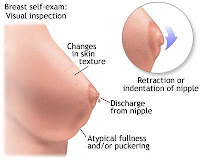Inflammation of the breast, or mastitis is an inflammation of the breast caused by infection in the breast tissue or due to blockages. Mastitis is divided into 3 namely periductal mastitis, pueperalis mastitis, and mastitis supurativa. The third type of mastitis is the result of different causes and conditions are also different.
Unlike breast cancer, this type of cancer may not cause a lump in the breast. Checking the breast with mammograms often fail to learn at an early stage breast cancer. Because growing so rapidly, usually has spread at the time of diagnosis.
Cause.
Puerperalis mastitis caused by infection in the breast tissue. Mastitis occurs in women who are breastfeeding because of the transfer of Germs from your baby’s mouth or the mouth of her husband. That’s because low oral health such as the mouth of someone who likes to smoke. Germs that cause most puerperalis mastitis is Staphylococcus aureus. Germs can also enter the penis because of injecting silicone or collagen injections, causing inflammation.
Supurativa mastitis. This type of mastitis is the most common. Similar to the previous type, this type of mastitis caused by staphylococcus bacteria. Can also be caused by the fungus, the TB Germs, and even syphilis.
Periductal mastitis usually occurs in women of menopausal age (above 45 years), the main cause is not known Clearly. On the expected result of hormonal changes and nursing activities in the past. At the time of menopause estrogen hormone decrease occurs that causes the dead tissue. Piles of dead tissue and breast milk causes blockage in the channels in the breast. Blockage causes the closing of the channel and eventually widen the channel in the rear, which is usually located behind the nipple. The result is the inflammatory reaction called periductal mastitis.
Symptoms – Symptoms
Inflammatory breast cancer can cause one or more of these symptoms:
– A breast is swollen, red, and warm
– A tender or painful breast
– Itching in the breast
– Sometimes the nipple into the breast instead of pointing out. This is called a retracted nipple.
– Changes in the skin, especially areas that looked thick and pitted like orange peel. Sometimes there are mountains in the skin and small bumps that looked like a rash or itching.
– Breasts are visible bruises on certain parts.
– Swollen lymph nodes in the armpit
– There are one or more lumps in the breast.
– There Fever
Mastitis is caused by bacteria, which caused the abscess, or collection of pus in a cavity in the breast glandular tissue. Pus which spread to other parts of the body can cause high fever and chills, sweating a lot, the decline in immune system, even to the decrease in consciousness.
These tests include:
* Estrogen and progesterone receptor status. Hormones estrogen and progesterone stimulate the growth of breast cells to normal, and some breast cancers. Hormone receptor status is an important piece of information that will help you and your doctor’s treatment plan.
* HER-2 receptor status. HER-2/neu is a protein that regulates the growth of some breast cancer cells. Approximately 25% of women with breast cancer have too many, of these will promote the growth of proteins.
Treatment of inflammatory breast
Treatment of mastitis tailored to the cause, if the blockage is usually given analgesic (pain relief), if the bacteria cause infections should be given antibiotics, but if it happens then abscess drainage should be done (the distribution of the pus).
Drug treatment is usually followed by surgery to remove the breast and lymph nodes. After surgery, radiation therapy is used to try to kill remaining cancer cells.
Read more →


